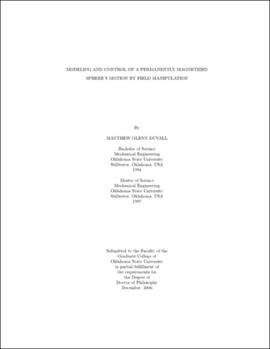| dc.contributor.advisor | Misawa, Eduardo A. | |
| dc.contributor.author | Duvall, Matthew Glenn | |
| dc.date.accessioned | 2013-11-26T08:28:22Z | |
| dc.date.available | 2013-11-26T08:28:22Z | |
| dc.date.issued | 2006-12 | |
| dc.identifier.uri | https://hdl.handle.net/11244/7032 | |
| dc.description.abstract | A model describing the motion of a magnetized sphere in a fluid medium subject to an applied field is developed. The inspiration for this system is rooted in technologies and procedures being explored in the biomedical community. In these systems, the accepted approximation of Stokes' flow about the sphere is discussed and limitations to this are identified with drag force relations accounting for wall effects presented. For this system, the sphere is approximated as a point dipole and the resulting electromagnetic force model is presented. For motion of the sphere using static electromagnets, a reduced coil set technique is proposed. The technique consists of utilizing the minimum number of coils for generation of the desired force on the sphere. This approach is in contrast to the existing solutions which use the full coil set for parallel and anti-parallel motion and single out a solution for the underdetermined system. A technique for determining the proper coil combination is developed from examining the definiteness of the geometric field functions. A coil array configuration consisting of a four coil assembly is investigated to facilitate planar motion of a magnetized spherical particle in a fluid medium. For this configuration, the reduced coil set consists of only two adjacent coils being active at any given time. The exact inverse current solution for the minimized coil set is derived and presented. The system dynamic model is formulated and represented in a nonlinear state space system. This study also derives analytical expressions describing the magnetic field and field gradient terms generated by an assembly of four coils grouped about a coordinate origin with the central axes of the coils all residing in the same plane. This model will prove to be quite useful for optimal design of an apparatus to serve as an experimental platform for such a system. The model predicts the magnetic field produced by an elliptically shaped coil, approximated as a finite number of rectangularly shaped loops. The law of Biot-Savart is utilized to calculate the magnetic field and field gradient terms for each loop. The loops are then used to approximate each turn of a wound coil and are superposed to calculate the total field generated by a single coil. Homogenous coordinate transforms are utilized to describe the field generated by the quad coil configuration. An analytical formulation based on finite loops for calculation of self inductance, mutual inductance, and resistance is also derived and presented. Magnetic field measurements of wound coils are performed and compared to the predictive model, with satisfactory results being demonstrated. The technique of representing the wound coils as an assemblage of finite loops is found sufficient to formulate a model which may be used for predictive modeling of a system to facilitate two dimensional motion of a magnetized sphere. A minimization routine based on discrete steepest descent gradient method is developed and presented. The functional used for the minimization routine has been developed and is established as the norm of instantaneous power applied to an adjacent set of coils. This allows for summary of the power in two coils by one calculation. The routine calculates the required coil spacing and coil geometry necessary to achieve motion of the magnetized sphere along a given circular trajectory with minimal power dissipation. Control of a small magnetized spherical particle in 2D space using a square arrangement of electromagnets is presented. A classical controller with and without feedforward is implemented in concert with a novel switching approach. A sample of the experimental results for motion of the particle along a desired trajectory in a fluid medium are presented and discussed. Further, the experimental results are compared with computer simulation results to get insights into the accuracy of the dynamic model. | |
| dc.format | application/pdf | |
| dc.language | en_US | |
| dc.rights | Copyright is held by the author who has granted the Oklahoma State University Library the non-exclusive right to share this material in its institutional repository. Contact Digital Library Services at lib-dls@okstate.edu or 405-744-9161 for the permission policy on the use, reproduction or distribution of this material. | |
| dc.title | Modeling and control of a permanently magnetized sphere's motion by field manipulation | |
| dc.contributor.committeeMember | Pagilla, Prabhakar R. | |
| dc.contributor.committeeMember | Chambers, Frank W. | |
| dc.contributor.committeeMember | Hagan, Martin T. | |
| osu.filename | Duvall_okstate_0664D_2067.pdf | |
| osu.accesstype | Open Access | |
| dc.type.genre | Dissertation | |
| dc.type.material | Text | |
| thesis.degree.discipline | Mechanical Engineering | |
| thesis.degree.grantor | Oklahoma State University | |
